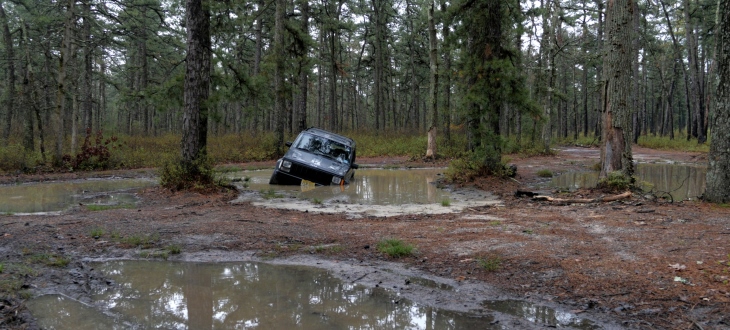The State We're In
Pine Barrens ‘mudders’ focus of new documentary
It was a warm, rainy May night in 2016 and filmmaker Jared Flesher was searching for threatened and rare Pine Barrens tree frogs. With help from a guide, he found himself next to a pond deep in the wilderness of Wharton State Forest.
“We could hear whippoorwills singing, then we heard this ‘quonk, quonk, quonk’ noise,” Jared recalled. The pond was alive with Pine Barrens tree frogs croaking their distinctive mating songs.
But Jared was disturbed. “We saw these huge tire tracks from monster trucks leading into the pond,” he said. “Then I started seeing all this litter – everything from beer cans to a moldy old mattress.”
The contrast between the beauty of the natural world and the ugliness of vandalism and trash convinced Jared that his next documentary would be about damage caused by off-road vehicles, also known as ORVs. “I knew at that moment that I’d found a story worth telling,” he said.
The new documentary is called “Pine Mud,” and it focuses on the destructive sport of “mudding,” in which ORVs are deliberately driven through ponds, streams and wetlands.
The story is told through Jason Howell, a native “Piney” who works as stewardship coordinator for the Pinelands Preservation Alliance, a nonprofit group dedicated to preserving and protecting the New Jersey Pine Barrens.
By lucky coincidence, Jason was Jared’s guide for a kayak trip in the Pine Barrens in April 2016. When Jared mentioned he wanted to film Pine Barrens tree frogs the following month for his nature series, “The Creature Show,” Jason offered to take him to a good spot. The rest is history.
In the trailer for “Pine Mud,” Jason is standing next to a peaceful stream surrounded by native vegetation. “If you could, imagine what would happen if someone took a monster truck in here and just churned and churned the soil until the vegetation was removed,” he says.
Viewers don’t have to imagine for long. The next scene shows a wetland-turned-mud hole, crisscrossed by tracks from giant tires. More footage shows trucks tearing and sliding through the mud, leaving deep gouges. Clearly, few plants or animals can survive such an onslaught.
“There are hundreds and hundreds of ponds in the Pine Barrens that have been damaged,” said Jared. “There are places where Pine Barrens tree frogs once lived, but they’re no longer there.”
Off-road driving in Wharton State Forest is not illegal, Jared noted. The state forest – New Jersey’s largest, at 122,880 acres or 192 square miles – has hundreds of miles of sand roads available to any licensed driver with a motor vehicle. No special permits are needed.
But problems occur when ORV drivers don’t stay on marked sand roads. Some drivers create “go arounds” to avoid potholes and obstructions.
Other drivers just want to kick up as much mud as possible. These “mudders” drive through puddles hard and fast, deepening and widening them. They veer off marked roads and create their own paths through forests, streams, ponds and wetlands.
While filming “Pine Mud,” Jared encountered three men from Virginia who drove five hours to go “mudding.” “The New Jersey Pine Barrens has gotten a reputation as a place where you can come and do damage and get away with it,” he said. “That’s a key problem my film identifies.”
In 2015, the New Jersey Department of Environmental Protection proposed a new “Motorized Access Plan” for Wharton State Forest that would have cut in half the number of miles of sand roads open to motor vehicles. But the plan was so strongly opposed by ORV riders that it was quickly abandoned by the state.
Jared said his documentary presents both sides of the ORV argument. “You might be a person who’s following all the rules for driving off-road, and you don’t think it’s fair” that access would be reduced, he said. “But other people think the ecological value of the land is so important that the ORV people have to give up some roads.”
Jason Howell is one of those people. “When I was a kid, I would often hear people say, this is just a bunch of pine trees. I always thought this place was something pretty special,” he said.
Now Jason is working to protect Pine Barrens habitats. “Anything where I can make even a little bit of difference … I’m into it, I’m very passionate about it,” he said.
Jared expects “Pine Mud” to be completed this summer. A Kickstarter campaign just raised more than $3,700 for the final filming, editing and distribution.
To keep up with the latest news on the documentary, go to the Creature Show website at www.creatureshow.com and click on the “Pine Mud” link. To find out more about off-road vehicles and the Wharton State Forest access plan, to the Pinelands Preservation Alliance website at www.pinelandsalliance.org/protection/hotissues/ecological/offroadvehicles/.
And for more information about preserving New Jersey’s land and natural resources, visit the New Jersey Conservation Foundation website at www.njconservation.org or contact me at info@njconservation.org.
About the Authors
Alison Mitchell
Co-Executive Director
John S. Watson, Jr.
Co-Executive Director
Tom Gilbert
Co-Executive Director, 2022-2023
Michele S. Byers
Executive Director, 1999-2021
View their full bios here.
Filter
Get The Latest News
From The Garden State
In the
News

